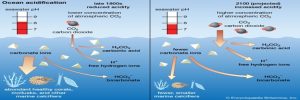“Behavior and Traits Water at High Temperatures and Pressure”

“Behavior and Traits Water at High Temperatures and Pressure”
Water, a remarkable compound composed of the elements hydrogen and oxygen, manifests itself in three fundamental states: gas, liquid, and solid. It stands as one of the most abundant and indispensable substances in our world. At room temperature, it takes the form of a colorless, tasteless, and odorless liquid with an exceptional ability to dissolve a wide range of other substances. This remarkable solubility is integral to many vital biological processes, where water serves as a universal solvent. It is believed that the origins of life took root in the aqueous solutions of Earth’s oceans, and living organisms rely on water-based solutions like blood and digestive fluids to sustain essential life functions.
Water’s influence extends beyond our planet, with its presence discovered on other celestial bodies within and outside our solar system. Although water might seem colorless in small quantities, its faint bluish hue is a result of the subtle absorption of red light at longer wavelengths, an effect due to the ordinary scattering of light.
Water’s molecular structure, consisting of two hydrogen atoms and one oxygen atom (H2O), may appear straightforward, but its physical and chemical characteristics are exceptionally intricate and diverge significantly from those of most other substances on Earth. For example, ice’s unique behavior, floating atop liquid water, is an extraordinary feature. In the case of nearly all other substances, the solid form is denser than the liquid phase, which would mean that ice should sink. However, the fact that ice floats is a vital phenomenon in the natural world, providing an insulating layer on the surfaces of cold region ponds and lakes, safeguarding the aquatic life below. If ice were denser than liquid water, entire bodies of water would eventually freeze, resulting in the loss of all aquatic life.
In its liquid state, water resides on Earth’s surface as a vital, fluid substance, serving an array of essential purposes in transportation, recreation, and as the habitat for countless plants and animals. It readily transitions into vapor (gas) and is transported from oceans to inland areas through the atmosphere, condensing and nurturing life as it falls in the form of rainfall.
On the terrestrial front, water predominantly exists in our planet’s major oceans (about 97.25%) and as polar ice caps and glaciers (approximately 2.05%). The remaining freshwater can be found in lakes, rivers, and underground aquifers. As our world’s population swells, and the demand for clean water surges, the processes of water purification and recycling grow increasingly vital. It’s intriguing to note that the criteria for water purity are often stricter for industrial applications than for human consumption. For example, water utilized in high-pressure boilers must be at least 99.999998% pure. This is due to the fact that seawater contains a significant amount of dissolved salts, necessitating desalination for most human uses, including numerous industrial applications. This article delves into the molecular composition of water, exploring its physical and chemical properties. For further information on various water applications, refer to hydrology, environmental studies, hydrosphere, ice, and pollution
give me some important question and answers for this topic”Behavior and Traits Water at High Temperatures and Pressure”
Q1: How does the behavior of water change as it is subjected to high temperatures and pressure? A1: The behavior of water undergoes significant changes under high temperatures and pressure. Discuss the alterations in its physical and chemical properties, including phase transitions and molecular dynamics.
Q2: What is the critical point of water, and how does it influence its behavior at extreme temperature and pressure conditions? A2: Explore the concept of the critical point of water, which represents the temperature and pressure beyond which distinct liquid and gas phases cease to exist. Discuss how water behaves near and beyond its critical point.
Q3: How do high temperatures and pressure impact the phase diagram of water, and what phases can water exhibit under extreme conditions? A3: Examine the phase diagram of water, specifically focusing on the changes induced by high temperatures and pressure. Discuss the various phases of water, such as supercritical fluid and other exotic states.
Q4: What role does water’s molecular structure play in its behavior at elevated temperatures and pressure, and how does it differ from its behavior at standard conditions? A4: Analyze the molecular structure of water and its influence on behavior under high-temperature and pressure conditions. Highlight any deviations from typical behavior, considering aspects like hydrogen bonding.
Q5: How is water’s solubility affected by changes in temperature and pressure, and what implications does this have for natural processes and industrial applications? A5: Investigate how alterations in temperature and pressure affect water’s solubility. Discuss the implications for natural processes, such as deep-sea environments, and industrial applications like high-pressure reactions.
Q6: What experimental techniques are employed to study the behavior of water under extreme conditions, and what insights have been gained from such studies? A6: Explore experimental techniques used to study water at high temperatures and pressure, such as diamond anvil cells or shock compression methods. Highlight key insights gained from these studies.
Q7: How does water behave in geothermal environments, and what significance does this behavior have for the Earth’s subsurface processes? A7: Discuss water’s behavior in geothermal environments, emphasizing its role in subsurface processes. Explore implications for geological phenomena like magma generation and hydrothermal systems.
Q8: In what ways can the behavior of water at high temperatures and pressure be applied in industrial processes, such as power generation or materials synthesis? A8: Examine practical applications of understanding water’s behavior in industrial settings. Discuss its relevance in power generation, materials synthesis, and other high-pressure applications.
Q9: How does water’s behavior at extreme conditions contribute to our understanding of planetary interiors, including those of gas giants or icy moons? A9: Explore how insights into water’s behavior under extreme conditions contribute to understanding planetary interiors. Discuss applications in studying gas giants, icy moons, and other celestial bodies.
Q10: Are there environmental or climate implications associated with changes in water behavior at high temperatures and pressure, and how might these impact ecosystems? A10: Discuss any environmental or climate implications arising from changes in water behavior at high temperatures and pressure. Explore potential impacts on ecosystems, climate systems, or hydrological cycles.

